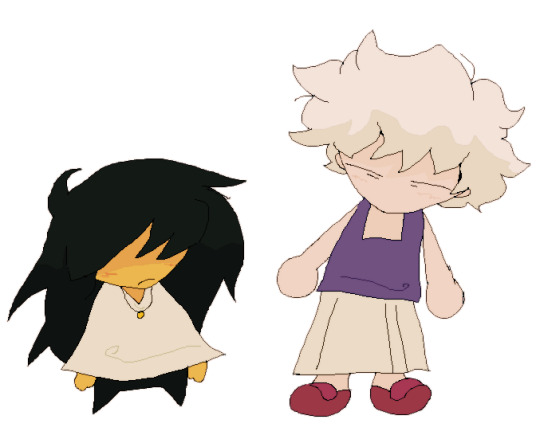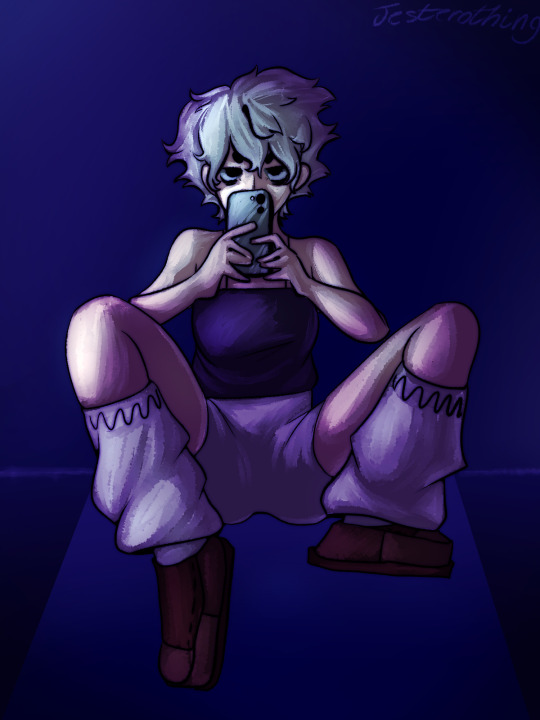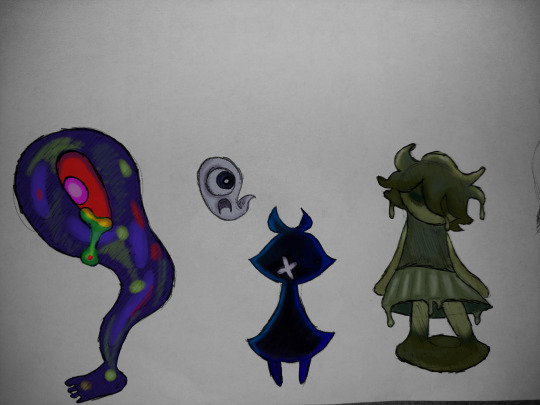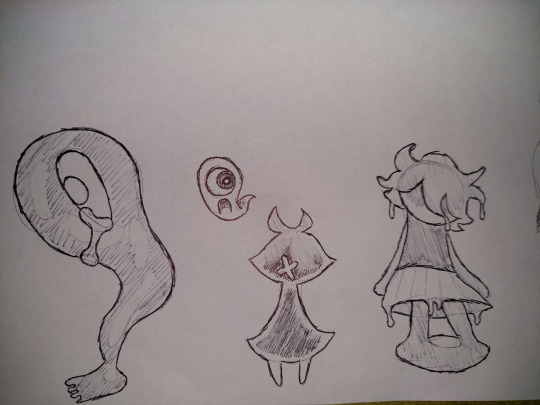#sabi .flow
Explore tagged Tumblr posts
Text
.Flow Week 2025 Day 6 | Plant effect / Contagion / Alternate outfit or multiple effects

Extras +


This was my first ever paperdoll, I think it looks nice.


Prompts belong to @rustedalleys
#my art#mixed media#traditional art#paper dolls#paperdoll#.flow#dotflow#.flow (game)#lolrust#dotflowweek2025#.flowweek2025#.flow week 2025#dotflow week 2025#sabitsuki#.flow sabitsuki#sabi .flow#ynfg#yume nikki fangame#ynfg fanart#plant effect#pipe effect#yume nikki online#dotflowweek25
85 notes
·
View notes
Text

#man i am on a roll today#this one's inspired by the sugar hole#and ofc sabi herself#i just think she's neat#.flow#dotflow#sabitsuki#.flow cleaner#gas mask#sugar hole#horror aesthetic#yume nikki
102 notes
·
View notes
Text

them
#no eyes vs no mouth#sabi is the pale as fuck friend#my stuff#lisa rpg#lisa armstrong#sabitsuki#.flow#dotflow
55 notes
·
View notes
Text

finally started playing dotflow so i could complete the holy trinity
man, I thought mado and uro were gender, LOOK AT THIS BUNDLE OF BRILLIANCE
#i am so normal about sabi#sabitsuki#dotflow#.flow#.flow (game)#.flow sabitsuki#.flow fanart#yume nikki#ynfg#yume nikki fangame#digital art#art#artists on tumblr#my art
63 notes
·
View notes
Text
.flow tumblr community now exists!
🧡 Hi, Dreamers! I just discovered that a .flow community has recently been created, yay!!! It's run by @sabi-rust and @3dsoplya, check it out here:
Also, if you want to learn more about how tumblr communities work, here's the official help page: https://help.tumblr.com/communities/
#sabi-rust#3dsoplya#.flow#dot flow#ynfg#yume nikki fangame#rpgmaker horror#tumblr community#(I did not create this community--just tagging myself 'cause I made this post.)#rustedalleys
8 notes
·
View notes
Note
sabitsuki, do u like ham sandwhiches
thas what im eating right now


"I envy you, though. sounds like something i would enjoy eating"
#sabs#asks#ask blog#.flow ynfg#.flow sabitsuki#((hc that because of the womb imagery and the amount of corpses in sabis dreams she can't stomach meat))
6 notes
·
View notes
Text

Some guys from those cool dream games


#unlabelled drawing tag#yume nikki#yume 2kki#.flow#ynfg#mars-san#follony#black hole girls yume 2kki#<- specifically the one from lunar sanctuary#sabitsuki#they're meant to be standing like an rpg encounter idk if that came across right#sabi's my favourite out of everyone i think she turned out the best#these aren't super proportionally accurate but idk#id in alt text
18 notes
·
View notes
Text
Smile witta smiley piercing nuff said
#dotflow#.flow#sabitsuki#ynfg#yume nikki fangame#yume nikki#if sabi can have a naval#then smile can have a smiley
7 notes
·
View notes
Text

alrighty babes, heres a wip thingy im doin, yes i know its rlly boring and flat and just nothing at all, and also wtf is she even doing with her left hand there I KNOW, this is just a wip i promise itll look slightly better once im done with it!!!!!!
but hey, anyways, for those who care: sabitsuki from dotflow/.flow drawing in progress, yes, she is my favorite, she will be getting special attention from me, dont worry uro and mado lovers theyre not getting the short end of the stick, its just that sabi is the most blorbo of them all to me <3
#.flow#dotflow#sabitsuki#.flow sabitsuki#.flow fanart#.flow (game)#ynfg#yume nikki fangame#dotflow sabitsuki#sabi#best suki teehee#art wip#current wip#unfinished#cock and balls#shes trans#shes a lesbian
6 notes
·
View notes
Text


hole in girl….
#.flow was huge to me as a 15 year old but then I forgot most of it?#spent so many hours just trawling around its dreamscape. sabi sabi
0 notes
Text

no comment
#my art#.flow#dotflow#ynfg#yume nikki fangame#fanart#fan art#sabitsuki#.flow sabitsuki#sabi .flow#.flow sabi#shitpost#smile (.flow)#smile .flow#.flow smile#kaibutsu (.flow)#.flow (game)#.flow kaibutsu#kaibutsu#.flow gabe#.flow james#.flow carrie#.flowtp#flowtp#I forgot my tags#for .flow stuff
41 notes
·
View notes
Text

.flow week day 2 - favorite effect @rustedalleys
Hoodie (cuz I think Sabi looks cool in it), gas mask and the pipe effect >:)
#dotflowweek25#dotflow#.flow#sabitsuki#sabitsuki dotflow#sabitsuki fanart#dotflow sabitsuki#sabitsuki .flow#.flow sabitsuki#.flow game#fanart#fan art#art#digital art#artists on tumblr#open comissions
174 notes
·
View notes
Text
.flow takes place on sabitsuki's pc so do you think her dreams are her just writing fanfiction
or does she just do that thing that i also do where you dissociate in front of your laptop thinking about stuff for hours without even looking at it
#i was silly on the first one but is there an actual theory of that?#like it's all just sabis writing#idk i started to like this piece of media very late#.flow
21 notes
·
View notes
Note
If the Dusk Court still existed alongside the other courts, what do you think it would look like? As well as its clothing and architecture. What would you want its culture to be like and what language do you think they would have?
If the Dusk Court still existed alongside the other courts, I imagine it as one of the most culturally profound and symbolically layered courts—the bridge between light and dark, life and death, change and permanence.
The Dusk Court — The Realm of Twilight and Transcendence
Dusk is neither day nor night—it’s a threshold, a liminal space. I see the Dusk Court as a place that thrives on balance, introspection, and reverence for the in-between. It’s a society that embraces ambiguity, transformation, and cyclical patterns—where nothing is static, and every ending is honored as a beginning.
1. Architecture: Inspired by Ancient Petra, Moroccan Riads, and Byzantine Influence
I picture the Dusk Court as a city carved into nature itself, much like Petra in Jordan—rose-stone facades, seamlessly blending into cliffs and canyons. The structures wouldn’t dominate the landscape, but emerge from it, reflecting the Court’s philosophy of harmony and transience.
From Moroccan architecture, I’d borrow the idea of hidden beauty—plain exteriors that open into stunning inner courtyards (riads) filled with fountains, tiled mosaics, and shaded gardens. Privacy and inner reflection would be key values, so homes and public buildings would focus inward, designed for contemplation and peace.
The spiritual heart of the court could resemble Byzantine basilicas, with grand domes, intricate mosaics of twilight skies, and soft light filtering through stained glass in muted golds, purples, and blues. The Hagia Sophia comes to mind—an architectural testament to both earthly grandeur and spiritual transcendence.
Key Features:
Sandstone cities glowing at sunset.
Reflective pools and labyrinthine streets, symbolizing life’s winding paths.
Open-air temples honoring celestial cycles, with no roofs to separate them from the skies.
Use of geometric patterns, similar to Islamic art, representing the infinite and unknowable.
2. Clothing: Rooted in Desert Cultures, Byzantine Luxury, and Japanese Minimalism
The Dusk Court’s fashion would blend practicality with philosophical symbolism.
Inspired by North African and Middle Eastern garments, they’d wear flowing robes and light, breathable fabrics—perfect for climates where days are hot and nights are cool. Think djellabas, kaftans, and abayas layered in soft gradients, echoing the shifting colors of twilight.
From Byzantine culture, I’d imagine intricate embroidery—threaded in gold and silver—depicting cosmic motifs: setting suns, crescent moons, stars, and cyclical patterns.
But there would also be a hint of Japanese aesthetics—a respect for simplicity, impermanence, and nature. Perhaps elements of wabi-sabi, where beauty is found in imperfection and age. Faded fabrics, hand-stitched repairs (like boro), and heirloom garments passed through generations would be common.
Color Palette:
Muted violets, soft ochres, deep indigos, dusty rose, and shimmering golds—colors that shift depending on light, embodying the transient beauty of dusk.
3. Culture: A Society of Philosophers, Mystics, and Keepers of Balance
The Dusk Court would be deeply philosophical—drawing from traditions like:
Taoism: The belief in balance and the flow of natural forces (yin and yang). They’d reject extremes, favoring harmony and the acceptance of life’s dualities.
Sufi Mysticism: A culture of poetry, dance, and music as forms of spiritual expression. Imagine whirling dervish-like rituals, where movement becomes a meditation on the cycles of life.
Ancient Egyptian View of Ma’at: The concept of cosmic balance, truth, and order. The Dusk Court might view themselves as guardians of Prythian’s metaphysical equilibrium, ensuring no court tips too far into chaos or tyranny.
Mesoamerican Calendar Culture: A deep reverence for time and celestial events. Festivals would align with equinoxes, solstices, and rare astronomical phenomena. Every citizen would know their place within cycles of renewal and decay.
They would embrace mortality—not fearing death, but seeing it as a sacred passage. Funeral rites would be grand, but not mournful—celebrations of completion.
4. Language: A Blend of Arabic Poetics, Sanskrit Philosophy, and Indigenous Symbolism
The Dusk Court’s language would be highly metaphorical, designed to convey layers of meaning in few words—similar to how Arabic or Persian poetry can express vast emotional landscapes through symbolism.
They might have untranslatable words akin to:
“Tarab” (Arabic): The ecstasy from music.
“Saudade” (Portuguese): A longing for something lost.
“Ikigai” (Japanese): A reason for being.
Like Sanskrit, their language could be tied to philosophy and ritual, with precise words for spiritual concepts and cosmic forces. Perhaps they use pictographs or glyphs in writing, resembling Mayan or Egyptian scripts, where a single symbol encapsulates complex ideas.
Communication wouldn’t be rushed—silence could be as important as speech.
5. Political & Economic Structure: The Court of Mediators and Memory
Politically, the Dusk Court would serve as Prythian’s neutral heart. A place where courts send emissaries to settle disputes, guided by ancient laws older than any High Lord.
Leadership might not be a singular ruler but a council of elders—chosen not for power but for wisdom and life experience. Perhaps titles aren’t inherited but earned through deeds reflecting balance, insight, and service to the community.
Economically, they’d thrive on:
Artisan goods: Glasswork that captures twilight, enchanted scrolls, and twilight-blooming plants used in rare potions.
Knowledge trade: Selling maps of ancient ley lines, star charts, and philosophical treaties prized by scholars of other courts.
Hosting diplomatic summits and neutral trade agreements.
Final Thoughts:
If the Dusk Court still existed, it would be the soul of Prythian—not the most powerful, not the richest, but the wisest. A court that understands that strength isn’t just about armies or magic, but about knowing when to let go, when to endure, and when to stand as the quiet force holding everything together.
It would draw from cultures that value introspection, balance, and spiritual depth.
#anti acosf#anti inner circle#anti acotar#anti rhysand#anti feysand#anti cassian#anti azriel#anti amren#anti morrigan#anti nessian#anti night court
46 notes
·
View notes
Text

.Flow week day 3 [Machine effect / Deepest fear (sort of)] I feel like Sabi would have some ever looming dread of dying considering everything.
54 notes
·
View notes
Text
The Philosophy of Wabi-Sabi
Wabi-sabi is a traditional Japanese aesthetic and worldview centered on the acceptance and appreciation of imperfection, impermanence, and the incomplete. It is deeply rooted in Buddhist teachings, particularly those relating to the transience of life. The philosophy of wabi-sabi celebrates the beauty found in simplicity, humility, and natural processes. Here’s an exploration of its core principles and concepts:
1. Impermanence (Mujō)
Transience of Life: Central to wabi-sabi is the Buddhist concept of impermanence (mujō), which acknowledges that all things are in a constant state of flux and decay. This perspective encourages an appreciation for the present moment and the beauty of fleeting experiences.
Natural Aging: Wabi-sabi finds beauty in the natural aging process. The patina of wear and the signs of use on objects are celebrated as they reveal the passage of time and the story of their existence.
2. Imperfection (Wabi)
Beauty in Flaws: Wabi-sabi embraces the idea that nothing is perfect, and it is in the imperfections that true beauty resides. This could be seen in asymmetry, roughness, and the uniqueness of handmade objects.
Simplicity and Humility: The wabi aspect emphasizes simplicity and humility. It values modest, rustic beauty over ostentatious or overly elaborate designs. This often translates to an aesthetic of minimalism and restraint.
3. Incompleteness (Sabi)
Unfinished and Evolving: The sabi aspect of wabi-sabi appreciates the incomplete and the evolving nature of things. It suggests that beauty is a process, not a fixed state, and that objects and experiences are always in a state of becoming.
Quietness and Serenity: Sabi also conveys a sense of quietness and serenity. It reflects a meditative quality, an appreciation for solitude and the tranquility found in understated beauty.
4. Connection to Nature
Natural Materials: Wabi-sabi often involves the use of natural materials that age gracefully over time, such as wood, stone, and clay. These materials reflect the organic processes of growth and decay inherent in nature.
Organic Forms: The aesthetic favors organic, irregular forms that mimic the irregularities found in nature, as opposed to geometric perfection.
5. Mindfulness and Presence
Living Mindfully: Embracing wabi-sabi encourages living mindfully and being present in the moment. It’s about appreciating the here and now, and finding contentment in the current state of things, despite (or because of) their imperfections.
Acceptance: Wabi-sabi involves accepting the natural cycle of growth and decay, and finding peace and contentment in this acceptance. It’s about letting go of the pursuit of perfection and embracing the reality of impermanence.
Examples in Practice
Tea Ceremony: The Japanese tea ceremony is a quintessential example of wabi-sabi in practice. The ceremony emphasizes simplicity, natural materials, and the appreciation of imperfections in the tea utensils, such as a crack in a teacup that adds character and history.
Kintsugi: The art of kintsugi, where broken pottery is repaired with gold or silver lacquer, highlights the philosophy of wabi-sabi. It transforms damage into beauty, celebrating the history and imperfection of the object.
Gardens: Traditional Japanese gardens often embody wabi-sabi principles with their asymmetrical layouts, natural elements, and deliberate incorporation of aged or weathered features.
The philosophy of wabi-sabi offers a profound shift in how we perceive beauty and value in the world. By embracing imperfection, impermanence, and incompleteness, wabi-sabi encourages us to find beauty in the everyday, to appreciate the simple and humble aspects of life, and to cultivate a deep connection with the natural world. It is a reminder to live mindfully, to cherish the present moment, and to find peace in the ebb and flow of life’s inevitable changes.
#philosophy#epistemology#knowledge#learning#education#chatgpt#Wabi Sabi#Japanese Philosophy#Impermanence#Imperfection#Incompleteness#Buddhist Teachings#Natural Aging#Simplicity#Humility#Organic Forms#Mindfulness#Tea Ceremony#Kintsugi#Traditional Gardens#Aesthetic Principles#Transience#Rustic Beauty#Minimalism#Cultural Philosophy
80 notes
·
View notes